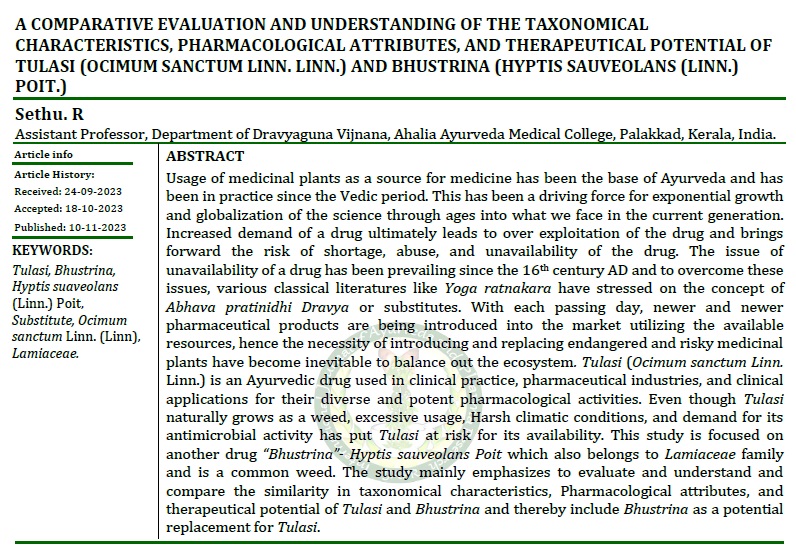A Comparative Evaluation and Understanding of the Taxonomical Characteristics, Pharmacological Attributes, and Therapeutical Potential of Tulasi (Ocimum sanctum Linn. Linn.) and Bhustrina (Hyptis sauveolans (Linn.) Poit.)
DOI:
https://doi.org/10.47070/ijapr.v11i10.3004Keywords:
Tulasi, Bhustrina, Hyptis suaveolans (Linn.) Poit, Substitute, Ocimum sanctum Linn. (Linn), LamiaceaeAbstract
Usage of medicinal plants as a source for medicine has been the base of Ayurveda and has been in practice since the Vedic period. This has been a driving force for exponential growth and globalization of the science through ages into what we face in the current generation. Increased demand of a drug ultimately leads to over exploitation of the drug and brings forward the risk of shortage, abuse, and unavailability of the drug. The issue of unavailability of a drug has been prevailing since the 16th century AD and to overcome these issues, various classical literatures like Yoga ratnakara have stressed on the concept of Abhava pratinidhi Dravya or substitutes. With each passing day, newer and newer pharmaceutical products are being introduced into the market utilizing the available resources, hence the necessity of introducing and replacing endangered and risky medicinal plants have become inevitable to balance out the ecosystem. Tulasi (Ocimum sanctum Linn. Linn.) is an Ayurvedic drug used in clinical practice, pharmaceutical industries, and clinical applications for their diverse and potent pharmacological activities. Even though Tulasi naturally grows as a weed, excessive usage, Harsh climatic conditions, and demand for its antimicrobial activity has put Tulasi at risk for its availability. This study is focused on another drug “Bhustrina”- Hyptis sauveolans Poit which also belongs to Lamiaceae family and is a common weed. The study mainly emphasizes to evaluate and understand and compare the similarity in taxonomical characteristics, Pharmacological attributes, and therapeutical potential of Tulasi and Bhustrina and thereby include Bhustrina as a potential replacement for Tulasi.
Downloads



